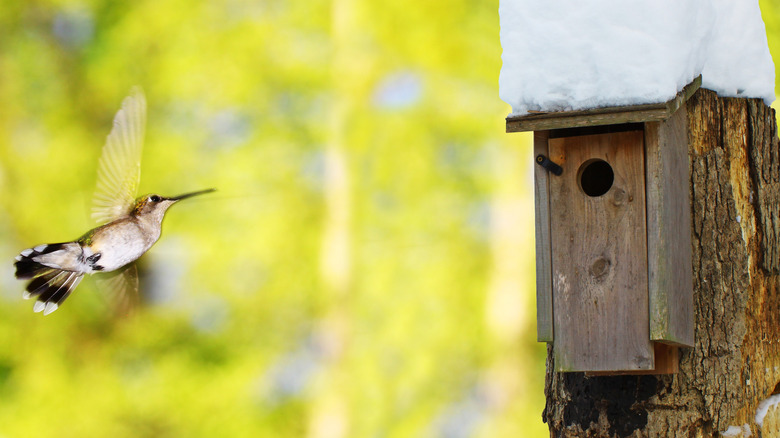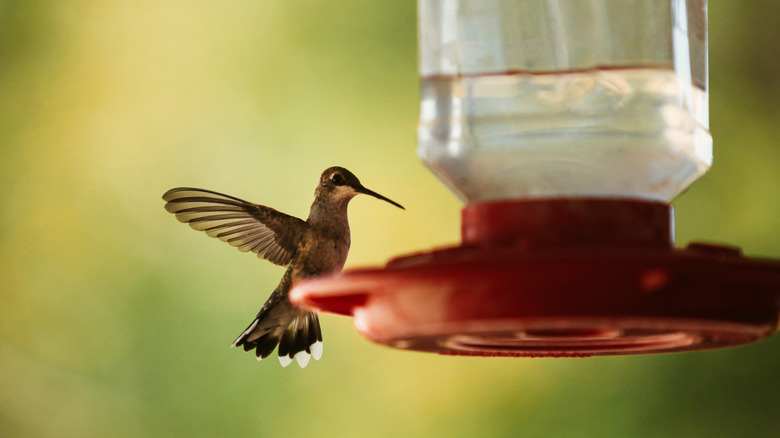Why Hummingbirds Aren't Using Your Birdhouse (And How To Identify A Nest)
Many enthusiasts set up birdhouses, hoping to attract hummingbirds to observe their behaviors up close or to admire these flying jewels. However, they often find themselves puzzled and disappointed when hummingbirds don't use the birdhouses set out for them. Why?
The most common reason hummingbirds ignore birdhouses is that these structures don't cater to their nesting preferences. John Shewey, the writer behind "The Hummingbird Handbook," explains that this is due to their biological and evolutionary makeup, as they will instinctively construct cup-shaped nests instead of cavity-nesting (i.e., natural or manufactured birdhouses).
A cup-shaped nest, as the term suggests, resembles the shape of a small cup or bowl. It's a bird nest characterized by its rounded, concave form that provides a secure and contained space for birds like hummingbirds to lay their eggs and raise their young. These nests are intricately woven or constructed from various materials, such as twigs, moss, leaves, grasses, and spider silk, depending on what is available in their environment. Therefore, a birdhouse placed in an open area without nearby foliage or cover is highly unlikely to attract a hummingbird.
Additionally, these birds choose nesting sites within easy flying distance of their food sources and require a constant supply of nectar to fuel their high metabolism. If your birdhouse is far from flowering plants, feeders, or water sources, it will undoubtedly be less appealing to them despite its evolutionary aversion. To be frank, if your goal is to attract hummingbirds, it's best to forego the birdhouse approach.
Encouraging hummingbirds to nest near you
That's why you should encourage hummingbirds to nest near you instead. Attracting hummingbirds to nest nearby involves creating a habitat that caters to their specific needs and natural behaviors. You'll need to start by developing a garden that mimics the natural feeding grounds of hummingbirds. This means planting various native, nectar-rich flowers that bloom at different times throughout the season to ensure a continuous food supply. Hummingbirds are particularly drawn to plants with vibrant, tubular blossoms like bee balm, honeysuckle, and foxglove, all excellent natural food sources.
Beyond leaving out cotton fluff and small pieces of string, consider offering a broader range of natural materials, such as delicate leaves, moss, and even small feathers. These materials can be placed in easily accessible areas to assist in nest construction. Providing a diverse array of materials encourages nesting and supports hummingbird nests' structural integrity and camouflage.
Moreover, try adding sugar-water hummingbird feeders to your backyard. Position the feeder in a clear, open space with nearby green foliage to ensure it's easily visible and offers protection. Also try adding water features like misters or shallow birdbaths to supply hummingbirds a spot to bathe and hydrate, attracting them closer to your garden.
Lastly, allow for a natural balance of insects, flowers, and nectar sources to support the hummingbirds' overall health and dietary needs. By avoiding pesticides and insecticides, you can encourage a biodiverse garden that benefits hummingbirds by protecting their food sources and supporting a healthy ecosystem.
Tips on how to find and identify a hummingbird nest
Hopefully, now, a nest can develop in your backyard. Identifying a hummingbird nest can be a delightful challenge due to the size of their nest, which is about two inches in diameter and one inch deep. It's also important to note that hummingbirds are very particular about the location of their nests. They look for sites that offer protection from predators and harsh weather conditions, naturally preferring spots high off the ground. Pay attention to locations five to 10 feet off the ground, though some nests might be higher (up to 90 feet).
You will most likely find these tiny, cup-shaped nests on the forks of branches, under leaves, wires, fenceposts, porchlights, or other structures that might offer protection. According to the American Bird Conservancy, one helpful hint is that they often look like tree knots. They mention that, given the small nature of the nests, you will most likely find it on thinner branches about one foot away from the trunk.
Finally, paying attention to hummingbird behavior can be a key to locating a nest. In particular, female hummingbirds, responsible for building the nest and caring for the chicks, can offer clues. If you observe a hummingbird consistently visiting the same spot in one day, especially if it's seen carrying nesting materials or food, there's a good chance a nest is nearby. Don't fret; you can turn your yard into a hummingbird haven; just don't count on your birdhouse.

